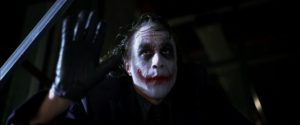(Author’s Note: In case you couldn’t tell, this article contains spoilers regarding the climax of The Dark Knight.)
 It’s now been fifteen years since the premiere of The Dark Knight, which quickly earned its place as both one of the greatest comic book movies and superhero movies ever, as well as the all-time greatest comic book superhero movie ever. It’s retained those titles with no sign of losing them any time soon, and yet I can’t help but feel the climatic face-off between Batman and the Joker could stand some improvement.
It’s now been fifteen years since the premiere of The Dark Knight, which quickly earned its place as both one of the greatest comic book movies and superhero movies ever, as well as the all-time greatest comic book superhero movie ever. It’s retained those titles with no sign of losing them any time soon, and yet I can’t help but feel the climatic face-off between Batman and the Joker could stand some improvement.
A quick recap of the sequence’s set-up: The Joker has filled two ferries with explosives, and placed the detonator for each ferry’s explosive in the other ferry. He informs the occupants of each ferry that he himself will blow up both ferries after a short amount of time, unless one ferry uses their detonator to blow up the other before then.
The Joker seems to believe that if a detonator is indeed used, it will vindicate his bitter philosophy of everyone willing to sacrifice others in the interests of self-preservation: “When the chips are down, these… ‘civilized people,’ they’ll eat each other.”
It’s certainly satisfying to some degree to see the Joker finally be proven wrong, and to be on the receiving end of one of the most brutal take-the-villain-down-a-peg lines imparted by the hero: “What were you trying to prove? That deep down, everyone’s as ugly as you? You’re alone.”
And yet the moment still doesn’t resonate as much as it should, since it’s questionable about what exactly the Joker was proven wrong. This is because when the scenario he devised faces further scrutiny, it seems doubtful the activation of one of the ferry’s detonators would prove much.
The core problem with the dilemma the Joker has crafted is that he presents the death of at least some people as inevitable — no matter what happens, some people are going to get blown up. Little evidence is shown that any of them have reason to believe Batman will show up to save the day.
Therefore, if anyone actually had used a detonator, they could easily excuse their actions to others and themselves as the needs of the many outweighing the needs of the few. “Look, it was either all of us or some of us. All I did was halve the number of victims.”
Oddly enough, the Joker didn’t need to settle for such an inconsequential “experiment.” He could have easily altered the rules to press its subjects to make a truly questionable decision with pretty much the same materials he had on hand. All he needed to do was take a page from Harvey Dent’s playbook.
Here’s how it would work: Everything prior to the Joker contacting the ferry passengers would remain the same. After informing them of the situation regarding the explosives and detonators, the Joker would flip a coin and cover it. He explains that after a certain amount of time, he will observe the coin. If it landed on heads, he will blow up both ferries. Tails, and he will let everyone go free. If one of the ferries is blown up before then, he will let the surviving passengers go, no matter which side the coin landed on.
And here’s where it gets truly diabolical: Regardless of whether a detonator is used or not, the Joker will announce to the ferries (or ferry) which side the coin had landed on. If people on one ferry opted to blow up the other, and it turned out the coin landed on tails, they will have to live the rest of their lives knowing they essentially killed scores of innocent people for nothing.
The only surefire method of emerging from the scenario unscathed would be to blow up the other ferry, and simply not to care whether it was at all necessary to so. The scheme would punish empathy and reward callousness.
If a ferry blew up with these rules in place, that would serve as a far more damning study of human nature (although still not a scientifically rigorous one). One must wonder why the Joker, who had spent the film demonstrating his tactical cunning, did not think of it.